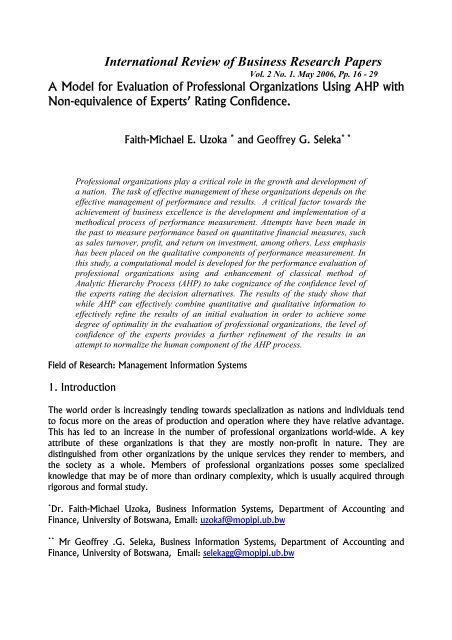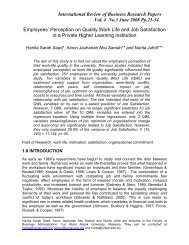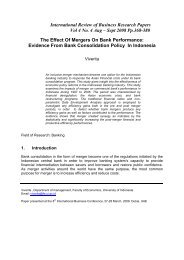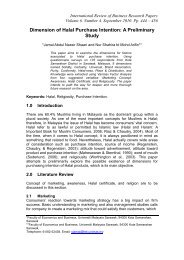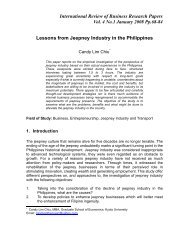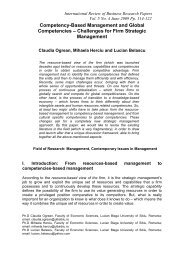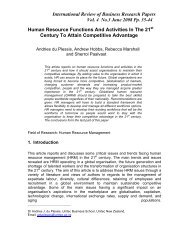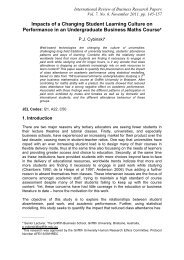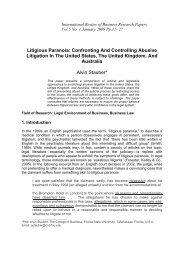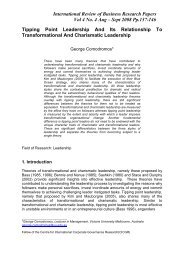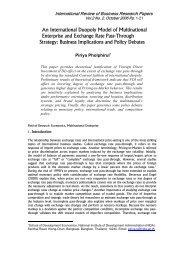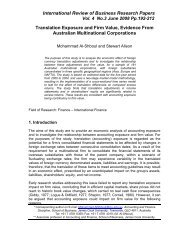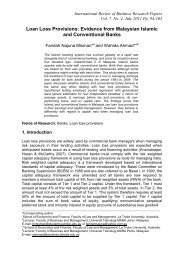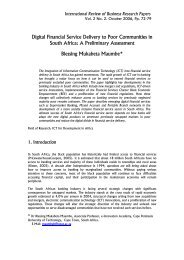A Model for Evaluation of Professional Organizations Using AHP ...
A Model for Evaluation of Professional Organizations Using AHP ...
A Model for Evaluation of Professional Organizations Using AHP ...
You also want an ePaper? Increase the reach of your titles
YUMPU automatically turns print PDFs into web optimized ePapers that Google loves.
International Review <strong>of</strong> Business Research PapersVol. 2 No. 1. May 2006, Pp. 16 - 29A <strong>Model</strong> <strong>for</strong> <strong>Evaluation</strong> <strong>of</strong> Pr<strong>of</strong>essional <strong>Organizations</strong> <strong>Using</strong> <strong>AHP</strong> withNon-equivalence <strong>of</strong> Experts’ Rating Confidence.Faith-Michael E. Uzoka * and Ge<strong>of</strong>frey G. Seleka * *Pr<strong>of</strong>essional organizations play a critical role in the growth and development <strong>of</strong>a nation. The task <strong>of</strong> effective management <strong>of</strong> these organizations depends on theeffective management <strong>of</strong> per<strong>for</strong>mance and results. A critical factor towards theachievement <strong>of</strong> business excellence is the development and implementation <strong>of</strong> amethodical process <strong>of</strong> per<strong>for</strong>mance measurement. Attempts have been made inthe past to measure per<strong>for</strong>mance based on quantitative financial measures, suchas sales turnover, pr<strong>of</strong>it, and return on investment, among others. Less emphasishas been placed on the qualitative components <strong>of</strong> per<strong>for</strong>mance measurement. Inthis study, a computational model is developed <strong>for</strong> the per<strong>for</strong>mance evaluation <strong>of</strong>pr<strong>of</strong>essional organizations using and enhancement <strong>of</strong> classical method <strong>of</strong>Analytic Hierarchy Process (<strong>AHP</strong>) to take cognizance <strong>of</strong> the confidence level <strong>of</strong>the experts rating the decision alternatives. The results <strong>of</strong> the study show thatwhile <strong>AHP</strong> can effectively combine quantitative and qualitative in<strong>for</strong>mation toeffectively refine the results <strong>of</strong> an initial evaluation in order to achieve somedegree <strong>of</strong> optimality in the evaluation <strong>of</strong> pr<strong>of</strong>essional organizations, the level <strong>of</strong>confidence <strong>of</strong> the experts provides a further refinement <strong>of</strong> the results in anattempt to normalize the human component <strong>of</strong> the <strong>AHP</strong> process.Field <strong>of</strong> Research: Management In<strong>for</strong>mation Systems1. IntroductionThe world order is increasingly tending towards specialization as nations and individuals tendto focus more on the areas <strong>of</strong> production and operation where they have relative advantage.This has led to an increase in the number <strong>of</strong> pr<strong>of</strong>essional organizations world-wide. A keyattribute <strong>of</strong> these organizations is that they are mostly non-pr<strong>of</strong>it in nature. They aredistinguished from other organizations by the unique services they render to members, andthe society as a whole. Members <strong>of</strong> pr<strong>of</strong>essional organizations posses some specializedknowledge that may be <strong>of</strong> more than ordinary complexity, which is usually acquired throughrigorous and <strong>for</strong>mal study.*Dr. Faith-Michael Uzoka, Business In<strong>for</strong>mation Systems, Department <strong>of</strong> Accounting andFinance, University <strong>of</strong> Botswana, Email: uzokaf@mopipi.ub.bw** Mr Ge<strong>of</strong>frey .G. Seleka, Business In<strong>for</strong>mation Systems, Department <strong>of</strong> Accounting andFinance, University <strong>of</strong> Botswana, Email: selekagg@mopipi.ub.bw
Uzoka and Seleka 17They are guided by certain values and standards, which are usually closely spelt out in a code<strong>of</strong> practice, or code <strong>of</strong> conduct, to which all members must commit themselves and alsoprovide a plat<strong>for</strong>m <strong>for</strong> interaction with government or other authorities in matters concerningthe pr<strong>of</strong>ession (Kolade 1998). They provide training and certifying examination <strong>of</strong> studentsin the pr<strong>of</strong>ession as well as the continuing pr<strong>of</strong>essional update and development <strong>of</strong> members,and promote the advancement <strong>of</strong> the pr<strong>of</strong>ession through research, publication <strong>of</strong> journals andperiodicals on matters that relate to the pr<strong>of</strong>ession.The per<strong>for</strong>mance <strong>of</strong> any organization is largely dependent on the realization <strong>of</strong> itsdistinguishing objectives. In the past, some per<strong>for</strong>mance measurement systems have beendeveloped, but these systems have been highly structured and quantitative, or global innature, attempting to meet the needs <strong>of</strong> every industry. Such global systems lose the specificsrequired <strong>for</strong> given industries. Extreme concern <strong>for</strong> global optimization in decision supportsystems could be counter productive because <strong>of</strong> the <strong>for</strong>ced translation <strong>of</strong> quantities which arenaturally expressed in different metrics into a common metric [Sands and Wisk<strong>of</strong>f 1996]. Itis noted in [Winston 1996] that no one model is able to effectively cater <strong>for</strong> the decisionneeds <strong>of</strong> two industries. Pr<strong>of</strong>essional organizations are unique due to their non-pr<strong>of</strong>it natureand membership orientation. Revenue growth is minimal, while members’ expectations <strong>for</strong>top quality pr<strong>of</strong>essional services remain high. Balancing these realities has been, and willcontinue to be the most significant challenge facing the leadership <strong>of</strong> these organizations. It isobserved (Kanji 2001) that effective organizational management depends on the effectivemanagement <strong>of</strong> per<strong>for</strong>mance and results. In order to achieve business excellence, it ispertinent that an organization develops a system <strong>for</strong> per<strong>for</strong>mance measurement.This study attempts to develop a per<strong>for</strong>mance evaluation model <strong>for</strong> pr<strong>of</strong>essional organizationsusing the <strong>AHP</strong> methodology. The <strong>AHP</strong> uses prioritization <strong>of</strong> variables by domain expertswhich is used rank decision alternatives based on ordinal or nominal scales. However, theevaluation does not take cognizance <strong>of</strong> the experiential confidence levels <strong>of</strong> the experts whorate the organizations. We propose an <strong>AHP</strong> methodology that integrates the overallconfidence level <strong>of</strong> the expert in his rating <strong>of</strong> organizations. In Section 2.0, we review someliterature relating to per<strong>for</strong>mance/productivity measurement. Section 3.0 addresses themethodology <strong>of</strong> our study, while Section 4.0 presents the results and discussion <strong>of</strong> findings.In Section 5.0, we present some conclusions and suggestions <strong>for</strong> further studies.2. Literature ReviewProductivity level is <strong>of</strong> critical importance to enterprise competitiveness. Many approacheshave been adopted <strong>for</strong> the measurement <strong>of</strong> organizational productivity. The method <strong>of</strong>measurement is <strong>of</strong>ten determined by the purpose <strong>of</strong> the productivity analysis, which mayinclude: comparing an enterprise with sector leaders or competitors, determining the relativeper<strong>for</strong>mance <strong>of</strong> departments and workers, comparing relative benefits <strong>of</strong> various types <strong>of</strong>17
Uzoka and Seleka 18input <strong>for</strong> collective bargaining, and gain sharing. One method <strong>of</strong> per<strong>for</strong>mance measurementis the use <strong>of</strong> inter-firm comparison (IFC) and benchmarking (NEDO 1981, ILO 1996). IFCinvolves the voluntary inter-firm exchange <strong>of</strong> in<strong>for</strong>mation regarding costs, per<strong>for</strong>mance,efficiency and other relevant data <strong>for</strong> purposes <strong>of</strong> comparative analysis, which showsmanagement how its firm’s per<strong>for</strong>mance compares with others in the same industry. IFC aimsat drawing management’s attention to areas <strong>of</strong> comparative weakness and strength within thebusiness, and to give management an objective basis <strong>for</strong> judging progress and effectiveness.Benchmarking on the other hand, goes beyond IFC. It is a collaborative approach wherebyseveral organizations share experience and help each other in productivity assessment byidentifying specific activities and practices that can, and ought to be changed in order toinitiate per<strong>for</strong>mance improvements that are sustainable.Kurosawa (1980) proposed a productivity measurement model, which focuses on thestructure <strong>of</strong> the enterprise, emphasizing an in<strong>for</strong>mation system that measures productivityaccording to the decision making hierarchy <strong>of</strong> the organization. Productivity <strong>of</strong> an individualor unit is seen as the value added to the organization by the individual or unit. Lawlor (1985)defined productivity measurement in terms <strong>of</strong> how organizations satisfy the followingparameters: objectives, efficiency, effectiveness, comparability and progressive trends.Bernolak (1993) proposed the combination <strong>of</strong> typical productivity and pr<strong>of</strong>itability ratios inestablishing the overall per<strong>for</strong>mance <strong>of</strong> the organization. The integrated analysis <strong>of</strong>pr<strong>of</strong>itability and productivity makes the application <strong>of</strong> productivity theory very practical <strong>for</strong>enterprise managers. While pr<strong>of</strong>itability measures indicate the combined short-term effects <strong>of</strong>price factors, the long-run success <strong>of</strong> enterprises is determined by proper resource utilization,which is the productivity factor.The logic model is proposed in (Hatry et al. 1996, McLaughlin and Jordan 1999, FairfaxCounty 2003) as a means <strong>of</strong> developing per<strong>for</strong>mance measures <strong>for</strong> organizations. The logicmodel captures a series <strong>of</strong> “If-then” changes that the programme intends to influence throughits inputs, activities and outputs. It is usually derived from a matrix <strong>of</strong> inputs, outputs andoutcomes, as depicted in Table 1. Logic models permit the use <strong>of</strong> eclectic approach toper<strong>for</strong>mance measurement, which permits either a walk <strong>for</strong>ward from inputs to outcomes, ora walk backwards from outcomes to inputs.Productivity improvement is the result <strong>of</strong> the combined ef<strong>for</strong>ts <strong>of</strong> many different stakeholderswith different objectives and perceptions about organizational effectiveness. This means thatthe results <strong>of</strong> measurement <strong>of</strong> different parameters should be fed back to all participants tostimulate improvement. ILO (1996) recommended that a “family <strong>of</strong> measures” should beused since no part <strong>of</strong> an organization is so simple that it can be measured adequately by oneindicator. By considering only a single measure or a few measures concentrated in onedimension, almost any group can be successful in the short term by optimising the selectedmeasure at the expense <strong>of</strong> other important measures. In (Fairfax County 2003), the family <strong>of</strong>measures approach was used in order to present a balanced picture <strong>of</strong> per<strong>for</strong>mance byutilizing a broad spectrum <strong>of</strong> indicators, which include input, output, efficiency, servicequality, outcome, among others.18
Uzoka and Seleka 19Table 1– A Logic <strong>Model</strong> MatrixINPUTS OUTPUTS OUTCOMESWhat weinvestStaffDollarsVolunteersMaterialsEquipmentWhat we do(Activities/Strategies)WorkshopsOutreachInspectionsAssessmentsShort-termAwarenessKnowledgeAttitudesSkillsMediumtermBehaviourDecisionsPoliciesLong-termConditionsSafetyEconomicSocialEnvironmeCertain difficulties arise in organizational per<strong>for</strong>mance measurement, which border on themethod <strong>of</strong> measurement and parameters considered. Such problems (ILO 1996) include:how to combine different types <strong>of</strong> input into one acceptable denominator; how to embraceall resources and business activities; how to deal with qualitative changes in input or outputover time; how to interpret measurement results; how to indicate accountability and provideclear signals <strong>for</strong> managerial decisions and action; and how to make productivity measurementcredible and easily understandable to everybody concerned in various parts <strong>of</strong> theorganization.The use <strong>of</strong> the logic model and family <strong>of</strong> measures has been cumbersome. This is because theprocess is usually long, and could become combinatorially explosive when the evaluationvariables are numerous. Productivity measurement and other multi-criteria evaluationdecisions are hierarchically structured (Liu and Wei 2000, Tsoi 2001). The AnalyticHierarchy Process, proposed by Saaty (1981), uses mathematical algorithms to trans<strong>for</strong>mqualitative subjective judgments into quantitative data, which produces a computationalmodel that serves as input into an evaluation process. Other methods <strong>of</strong> multi-criteriadecision analysis (MCDA) include: Preference Ranking Organization METHod <strong>for</strong> Enrichment<strong>Evaluation</strong>s [PROMETHEE] (Brans and Vincke, 1985), Technique <strong>for</strong> Order Preference bySimilarity to Ideal Solution [TOPSIS] (Hwang and Yoon, 1981), Ordered WeightedAveraging [OWA] (Yager, 1988), the Simple Additive Weighting [SAW] (Hwang andYoon, 1981), Data Envelopment Analysis [DEA] (Charnes et al. 1978), the ELECTRE(Roux and Elloy, 1985), and Fuzzy Ranking [FR] method (Critto et al. 2002). <strong>AHP</strong> ispreferred to other MCDA methods because it meets the MCDA method properties <strong>of</strong>interaction, weighting, dominance, and scaling (Naumann, 1998).With the <strong>AHP</strong> the analyststructures a problem hierarchically and then, through an associated measurement-anddecompositionprocess, determines the relative priorities consistent with overall objectives(Hartwich and Janssen 2000). However <strong>AHP</strong> utilizes domain experts’ judgments in settingcriteria priorities and rating decision alternatives. There are differences in the pr<strong>of</strong>essional andexperiential knowledge <strong>of</strong> the domain experts who carry out the ratings. This study is acontribution to recent attempts to recognize these differences in prioritizing decision variablesand rating <strong>of</strong> the decision alternatives ( Mikhailov, 2004; Beynon, 2005).19
Uzoka and Seleka 203. MethodologyThe study population consists <strong>of</strong> pr<strong>of</strong>essional organizations in Nigeria. As at the time <strong>of</strong> thestudy, there were thirty seven pr<strong>of</strong>essional bodies in Nigeria, out <strong>of</strong> which only nineteen wereregistered with the Association <strong>of</strong> Pr<strong>of</strong>essional Bodies <strong>of</strong> Nigeria (APBN). Ten out <strong>of</strong> thesewere randomly sampled <strong>for</strong> the purpose <strong>of</strong> the research. A total <strong>of</strong> one hundredquestionnaires were administered to pr<strong>of</strong>essionals in these organizations, with various levels <strong>of</strong>experience and qualifications (Table 2) who made judgments regarding relative levels <strong>of</strong>importance <strong>of</strong> the evaluation decision variables. The utilization <strong>of</strong> person-to-person contactensured proper filling and return <strong>of</strong> seventy two <strong>of</strong> the questionnaires. The followingparameters were considered in determining the per<strong>for</strong>mance <strong>of</strong> the pr<strong>of</strong>essional bodies:Pr<strong>of</strong>essional Development, Finance and Budget, Membership Services, and Human ResourcesManagementTable 2 – Distribution <strong>of</strong> RespondentsAge (x years) x < 20 20 ≤ x < 40 40 ≤ x < 60 x ≥ 603% 34% 49% 14%Experience (y years) y < 5 5 ≤ y < 15 15 ≤ y < 25 y ≥ 2516% 52% 27% 5%Highest Qualification < B.Sc. B.Sc. (or equivalent) M.Sc. (or equivalent) PhD6% 54% 37% 3%The decision support base <strong>for</strong> determining per<strong>for</strong>mance <strong>of</strong> pr<strong>of</strong>essional organization is built onthe <strong>AHP</strong> principle (Saaty 1981, Saaty and Vargas 1998). The Analytic Hierarchy Process(<strong>AHP</strong>) attempts to handle multi-criteria decisions in order to determine the relativeimportance <strong>of</strong> the evaluation variables in the decision process. When the amount <strong>of</strong> variablesto be combined in a decision process becomes many, the expert’s preference may decay andmay not be able to make effective comparison. This is because the human mind caneffectively handle at most 7 ± 2 pieces <strong>of</strong> in<strong>for</strong>mation at the same time, and becomesinefficient as the number <strong>of</strong> in<strong>for</strong>mation increases (Miller 1956). The <strong>AHP</strong> deals withdependence among variables or clusters <strong>of</strong> a decision structure to combine structured andunstructured in<strong>for</strong>mation. The <strong>AHP</strong> is based on three principles: decomposition,measurement <strong>of</strong> preferences and synthesis.Decomposition breaks down a problem into manageable elements that are treatedindividually. It begins with implicit description <strong>of</strong> the problem (the goal) and proceedslogically to the criteria (or states <strong>of</strong> nature), in terms <strong>of</strong> which outcomes are evaluated. Theresult <strong>of</strong> this phase is a hierarchical structure, consisting <strong>of</strong> levels <strong>for</strong> grouping issues togetheras to their importance or influence with repect to the elements in the adjacent levels above.The decomposition <strong>of</strong> the pr<strong>of</strong>essional organization evaluation decision into hierarchy ispresented in Figure 1, while the hierarchical structure is shown in Figure 2.20
Uzoka and Seleka 21Level 1 –Goal Level 2-criteria Level 3 – VariablesPer<strong>for</strong>mancemeasurement<strong>of</strong> Pr<strong>of</strong>essionalPr<strong>of</strong>essionalDevelopment (PFD)Finance and Budget(FNB)Codes and standards (CDS), position papers(PSP), Technical visits (TCV), Workshops andseminars (WSS), conferences (CFS), Researchand Publications (RPB), Mandatory ContinuingPr<strong>of</strong>essional Development (MCP)Donations/Benevolence (DBV), Pr<strong>of</strong>itableInvestments (PFI), Budget Per<strong>for</strong>mance (BGP),Revenue Generation (RGT)Organization Membership Jobs/IT placement (JIT), Pr<strong>of</strong>essionalServices (MBS) Examination (PFE), Arbitrations (ARB),(PMPO)Membership Drive (MBD), Subscriptions (SBS).Human Resources Staff Recruitment (STR), Staff Training andManagement Development (STD), Staff Compensation(STC), Staff Motivation (STM), StaffPer<strong>for</strong>mance <strong>Evaluation</strong> (SPE)Figure 1 – Hierarchy <strong>of</strong> Per<strong>for</strong>mance Measurement CriteriaMeasurement <strong>of</strong> preferences involves a pairwise comparison <strong>of</strong> decision variables, which areverbal statements about the strength <strong>of</strong> importance <strong>of</strong> a variable over another, representednumerically on an absolute scale. The comparison is done from the top level <strong>of</strong> the hierarchyto the bottom level in order to establish the overall priority index. If two varaiables are <strong>of</strong>equal importance, the rating <strong>of</strong> the comparison is 1. If variable A is strongly more importantthan variable B, then the rating <strong>of</strong> the comparison (AB) could be 7. If A is weakly moreimportant, the rating is 3. The reciprocal <strong>of</strong> the ratings show the converse <strong>of</strong> the relativeimportance. To obtain a fair judgment <strong>of</strong> the comparisons, mean values <strong>of</strong> the comparisonratings made by the seventy two pr<strong>of</strong>essionals were used in <strong>for</strong>mulating the pairwisecomparison (PWC) matrix <strong>of</strong> the variables in levels 2 and 3 <strong>of</strong> Figure 1. The Pairwisecomparison (PWC) matrix <strong>for</strong> the level 2 criteria is shown in Table 3, while that <strong>of</strong> level 3variables (<strong>for</strong> pr<strong>of</strong>essional development) is shown in Table 4.21
Uzoka and Seleka 22Per<strong>for</strong>mance DecisionLevel 2Pr<strong>of</strong>essionalDevelopment Finance and Budget Membership Services Human Resources ManagementDBVPFIBGPRGTSTR STD STC STM SPECDS PSD TCV WSS CFS RPB MCPLevel 3JIT PFE ARB MBD SBSFigure 2 – Hierarchical structure <strong>of</strong> evaluation variablesTable 3 – Level 2 PWC MatrixPFD FNB MBS HRMPFD 1 6 5 7FNB 1/6 1 ½ 3MBS 1/5 2 1 4HRM 1/7 1/3 ¼ 1Table 4 – PWC Matrix <strong>for</strong> Pr<strong>of</strong>essionalDevelopment (Level 3)CDS PSP TCV WSS CFS RPB MCPCDS 1 5 9 ¼ 7 5 ¼PSP 1/5 1 8 1/3 3 2 ¼TCV 1/9 1/8 1 1/7 1/8 1/6 1/8WSS 4 3 7 1 3 3 ¼CFS 1/7 1/3 8 1/3 1 1/3 1/6RPB 1/5 ½ 6 1/3 3 1 1/6MCP 4 4 8 4 6 6 1Synthesis involves the computation <strong>of</strong> eigenvalues and the eigenvector. In synthesizing thejudgments, the values in each column <strong>of</strong> the PWC matrix are first added. Then each entry ineach column is divided by the total <strong>of</strong> the column to obtain the normalized matrix, whichpermits meaningful comparison among elements. Finally, adding the values in each row <strong>of</strong> thenormalized matrix and dividing the rows by the number <strong>of</strong> row entries gives the average over22
Uzoka and Seleka 23the rows. This synthesis yields the percentage <strong>of</strong> relative priorities, which is expressed in alinear <strong>for</strong>m to give the eigenvector. The implication <strong>of</strong> the eigenvector is that it expresses therelative importance <strong>of</strong> an attribute over another in the minds <strong>of</strong> the decision maker. Theeigenvalues/ eigenvector computations can be expressed mathematically as follows:VEij=Tij. j(1)where E ij is the eigenvalue <strong>of</strong> cell {aij}, Vij is the value <strong>of</strong> PWC matrix <strong>for</strong> cell {aij}, andis the sum <strong>of</strong> the values on column jT.jThe eigenvector <strong>for</strong> variable k is a column vector given as:n∑Ekjj = 1λk=(2)nwhere k is the eigenvector value corresponding to variable k, Ekj is the eigenvalue <strong>of</strong> cell {akj},(j = 1,2, …,n), and n is the number <strong>of</strong> evaluation variablesThis initial table <strong>of</strong> eigenvalues and eigenvector helps to establish priority model. It isimportant to note that the pairwise comparisons are also carried out <strong>for</strong> elements <strong>of</strong> the subcriteria(variables) <strong>of</strong> all evaluation criteria (factors). The eigenvalues and eigenvector <strong>for</strong> thelevel 2 criteria are shown in Table 5.Table 5 – Level 2 Eigenvalues and EigenvectorPFD FNB MBS HRM EigenvectorPFD 0.662 0.643 0.741 0.467 0.6283FNB 0.111 0.107 0.074 0.200 0.1230MBS 0.132 0.214 0.148 0.267 0.1903HRM 0.095 0.036 0.037 0.067 0.0588The next step is the rating <strong>of</strong> the pr<strong>of</strong>essional organizations based on the respective variables.The evaluation <strong>of</strong> the ten pr<strong>of</strong>essional bodies used in this study was carried out using anevaluation sheet that was designed to generate evaluations in terms <strong>of</strong> the twenty onevariables identified in Figure 1. These evaluations were carried out by the seventy twoexperts. A crucial component <strong>of</strong> the questionnaire was the determination <strong>of</strong> the level <strong>of</strong>confidence x (0
Uzoka and Seleka 24n∑W i= λ R µj = 1jijij(3)where Wi is the weighted rating <strong>of</strong> organization i, j is the eigenvector value <strong>of</strong> variable j, Rij isthe rating <strong>of</strong> organization i on variable j, ij is the mean confidence level <strong>of</strong> the rating o<strong>for</strong>ganization i on variable j.This <strong>for</strong>ms the basis <strong>of</strong> ranking that leads to the eventual rating <strong>of</strong> the per<strong>for</strong>mance <strong>of</strong> theorganization.4. Results and AnalysisThe level 2 criteria evaluation gives an eigenvector, 1 that <strong>for</strong>ms the Pr<strong>of</strong>essional Body<strong>Evaluation</strong> Factor Index (PBEFI) in respect <strong>of</strong> the level 2 criteria.PBEFI = 0.6283PFD + 0.1230FNB + 0.1903MBS + 0.0588HRM (4)Expanding (4) using the eigenvalues/vector matrices <strong>for</strong> the four factors, we have:PBEFI = 0.6283 (0.1991CDS + 0.0960PSP + 0.0193TCV + 0.1926WSS +0.0570CFS + 0.0714RPB + 0.3646MCP) + 0.1230 (0.0653DBV + 0.2385PFI +0.1128BGP + 0.6100RGT) + 0.1903 (0.0306JIT + 0.3382PFE + 0.0610ARB +0.3754MBD + 0.1948SBS) + 0.588 (0.1924STR + 0.3626STD + 0.0702STC +0.0936STM + 0.02394SPE) (5)This translates to:PBEFI = 0.1251CDS + 0.0603PSP + 0.0121TCV + 0.1210WSS + 0.0358CFS +0.0449RPB + 0.2291MCP + 0.0081DBV + 0.0293PFI + 0.0139BGP + 0.0750RGT+ 0.0058JIT + 0.0644PFE + 0.0116ARB + 0.0714MBD + 0.0371SBS +0.0113STR + 0.0213STD + 0.0041STC + 0.0055STM + 0.0014SPE (6)The initial evaluation <strong>of</strong> the ten pr<strong>of</strong>essional organizations be<strong>for</strong>e the application <strong>of</strong> the <strong>AHP</strong>is presented in Table 6. These evaluations were carried out by the seventy two experts.<strong>Evaluation</strong> bias was localized by asking each pr<strong>of</strong>essional to evaluate his organization based onthe twenty variables identified in Figure 1. The evaluations were carried out based on a fivepoint qualitative likert scale as follows: poor-1, fair-2, good-3, very good-4, excellent-5. Asimple average <strong>of</strong> the evaluations was taken in each case, and approximated to the nearestnatural number on the likert scale. For purposes <strong>of</strong> anonymity, the organizations arerepresented by hypothetical organization identification numbers. After the application <strong>of</strong>PBEFI generated by <strong>AHP</strong>, the final evaluation was arrived at as shown in Table 7.Table 6 – Initial <strong>Evaluation</strong> <strong>of</strong> <strong>Organizations</strong>Org CDS PSP TCV WSS CFS RPB MCP DBV PFI BGP RGT JIT PFE ARB MBD SBS STR STD STC00001 3 4 5 3 5 3 2 4 4 2 3 4 4 3 4 3 2 2 300002 4 3 4 5 5 4 4 3 4 3 4 3 5 2 4 4 4 3 400003 3 2 3 3 4 2 2 2 4 4 3 2 3 2 3 3 3 3 300004 3 1 3 4 5 3 1 3 3 2 3 2 3 2 4 3 3 3 400005 2 2 3 2 3 2 1 1 3 2 2 1 3 1 3 2 2 2 200006 2 1 3 3 3 2 1 2 2 2 2 2 3 2 3 2 3 2 200007 3 3 4 2 4 3 1 2 3 2242 2 3 2 3 2 2 2 200008 1 2 3 3 3 2 1 1 3 2 2 1 4 1 3 2 3 2 200009 1 2 2 2 3 1 1 2 2 2 1 1 3 1 2 1 2 2 200010 2 2 3 2 2 1 1 1 2 2 2 2 3 2 3 2 2 2 2
Uzoka and Seleka 25The ratings in Table 6 show that the organization with identification number 0002 rankedfirst, while 00001 ranked second, and so on. After the application <strong>of</strong> the PBEFI on Table 6,the final ranking shows that organizations 00003 and 00004, which were both tied on thethird position in the initial ranking, now rank third and fourth respectively (Table 7).Organization with identification number 00006, which ranked fourth in the initial ranking,now ranks seventh. The results show that <strong>AHP</strong> is able to provide a mathematical <strong>for</strong>malism<strong>for</strong> refining the results <strong>of</strong> the initial rakings <strong>of</strong> the pr<strong>of</strong>essional organization, which could serveas an initial basis <strong>for</strong> decision making concerning the per<strong>for</strong>mance <strong>of</strong> these pr<strong>of</strong>essionalorganizations.With the introduction <strong>of</strong> the confidence levels <strong>of</strong> the experts on the ratings <strong>of</strong> theorganizations (Table 8), a further refinement <strong>of</strong> the evaluation results is carried out throughthe scaling <strong>of</strong> the results obtained in Table 7 using the relationship:1S = A. (7)TCwhere S is the final score matrix, A is the matrix shown in Table 7 less the last two columns,while C T is the transpose <strong>of</strong> the matrix shown in Table 8.Table 7 – <strong>Evaluation</strong> Result based on <strong>AHP</strong>Org. CDS PSP TCV WSS CFS RPB MCP DBV PFI BGP RGT JIT PFE ARB MBD SBS STR STD STC STM00001 0.375 0.241 0.061 0.363 0.179 0.135 0.458 0.032 0.117 0.028 0.225 0.023 0.258 0.035 0.286 0.111 0.023 0.043 0.012 0.000002 0.500 0.181 0.048 0.605 0.179 0.180 0.916 0.024 0.117 0.042 0.300 0.017 0.322 0.023 0.286 0.148 0.045 0.064 0.016 0.000003 0.375 0.121 0.036 0.363 0.143 0.088 0.458 0.016 0.117 0.056 0.225 0.012 0.193 0.023 0.214 0.111 0.034 0.064 0.012 0.000004 0.375 0.060 0.036 0.484 0.179 0.135 0.229 0.024 0.088 0.028 0.225 0.012 0.193 0.023 0.286 0.111 0.034 0.064 0.016 0.000005 0.250 0.121 0.036 0.242 0.107 0.090 0.229 0.008 0.088 0.028 0.150 0.006 0.193 0.012 0.214 0.074 0.023 0.043 0.008 0.000006 0.250 0.060 0.036 0.363 0.107 0.090 0.229 0.016 0.059 0.028 0.150 0.012 0.193 0.023 0.214 0.074 0.034 0.043 0.008 0.000007 0.375 0.181 0.048 0.242 0.143 0.135 0.229 0.016 0.088 0.028 0.150 0.012 0.193 0.023 0.214 0.074 0.023 0.043 0.008 0.100008 0.125 0.121 0.036 0.363 0.107 0.090 0.229 0.008 0.088 0.028 0.500 0.006 0.258 0.012 0.214 0.074 0.034 0.043 0.008 0.000009 0.125 0.121 0.024 0.242 0.107 0.045 0.229 0.016 0.059 0.028 0.075 0.006 0.193 0.012 0.143 0.037 0.023 0.043 0.008 0.000010 0.250 0.121 0.036 0.242 0.072 0.045 0.229 0.008 0.059 0.028 0.150 0.012 0.193 0.023 0.214 0.074 0.023 0.043 0.008 0.0The implication <strong>of</strong> the relationship in (7) is that if the average confidence level <strong>of</strong> the raterson a given variable is high, then their ratings would have averaged close to the realistic value,but if the average confidence level is low, then the reciprocal <strong>of</strong> the confidence value wouldeither increase or reduce the ratings accordingly in order to approximate the realistic value.Table 8 – Average Confidence Levels <strong>of</strong> Experts on the RatingsOrg CDS PSP TCV WSS CFS RPB MCP DBV PFI BGP RGT JIT PFE ARB MBD SBS STR STD STC STM00001 0.9 0.7 0.8 0.7 0.9 0.6 0.6 0.7 0.7 0.8 0.7 0.5 0.5 0.6 0.6 0.9 0.4 0.5 0.6 0.600002 0.7 0.6 0.7 0.9 0.8 0.7 0.7 0.8 0.5 0.4 0.6 0.9 0.7 0.5 0.8 0.8 0.7 0.6 0.6 0.400003 0.5 0.5 0.6 0.6 0.7 0.5 0.5 0.6 0.7 0.5 0.6 0.8 0.8 0.7 0.7 0.7 0.6 0.8 0.9 0.700004 0.6 0.8 0.8 0.7 0.8 0.5 0.3 0.6 0.8 0.6 0.6 0.6 0.6 0.7 0.5 0.8 0.5 0.8 0.5 0.400005 0.4 0.7 0.7 0.7 0.5 0.4 0.4 0.7 0.5 0.6 0.6 0.5 0.6 0.9 0.8 0.5 0.8 0.5 0.4 0.800006 0.9 0.6 0.6 0.8 0.5 0.5 0.7 0.4 0.7 0.7 0.6 0.4 0.7 0.8 0.6 0.6 0.9 0.7 0.6 0.600007 0.8 0.6 0.7 0.7 0.6 0.6 0.5 0.6 0.8 0.8 0.4 0.6 0.5 0.5 0.9 0.8 0.7 0.7 0.7 0.900008 0.6 0.8 0.6 0.8 0.5 0.3 0.8 0.6 0.9 0.4 0.7 0.6 0.9 0.7 0.4 0.6 0.4 0.8 0.5 0.700009 0.7 0.5 0.6 0.8 0.6 0.4 0.6 0.9 0.6 0.5 25 0.8 0.8 0.8 0.7 0.6 0.9 0.7 0.6 0.8 0.800010 0.9 0.6 0.7 0.7 0.7 0.5 0.4 0.6 0.4 0.5 0.7 0.6 0.6 0.8 0.7 0.8 0.9 0.9 0.6 0.6
Uzoka and Seleka 26Applying equation (7) to Tables 7 and 8 produces the final evaluation result, shown in Table9. This is a refinement <strong>of</strong> the evaluation result obtained by <strong>AHP</strong> to include the confidencelevels <strong>of</strong> the experts evaluating the organizations.Table 9 – Final <strong>Evaluation</strong> ResultOrg Id Final Rating Rank00001 4.518893 400002 5.732718 100003 4.574631 300004 4.577952 200005 3.607595 700006 2.979794 800007 3.664917 600008 3.713016 500009 2.380044 1000010 2.942111 9From Table 9, it could be observed that the organizations with ids. 00002, 00003, 00009,and 00010 still retained their first, third, tenth and ninth positions respectively. However,the following organization pairs interchanged positions respectively: {00001, 00004},{00005, 00006}, {00007, 00008}. The implication is that the initial ratings producedresults which may have been affected by the degree <strong>of</strong> confidence <strong>of</strong> the experts who ratedthe organizations. However, this was refined by using the confidence levels to deflate theinitial ratings.The study further reveals that high premium is placed on pr<strong>of</strong>essional development, which hasan eigenvector value <strong>of</strong> 62.83% (equation 4). In particular, pr<strong>of</strong>essional organizationsemphasize codes and standards (12.51%), and workshops/seminars (12.10%) as keydeterminants <strong>of</strong> per<strong>for</strong>mance.5. Conclusion and RecommendationsMeasuring per<strong>for</strong>mance <strong>of</strong> a service oriented organization such as a pr<strong>of</strong>essional body is acomplex managerial function that requires the combination <strong>of</strong> quantitative and qualitativedecision variables. These variables are in most cases, hierarchically structured. The decisionsupport model proposed in this study, constructs a hierarchy <strong>of</strong> decision criteria, which aremainly qualitative in nature. This can be effectively used to carry out the per<strong>for</strong>mancemeasurement <strong>of</strong> pr<strong>of</strong>essional organizations and a comparative measurement, with a view toranking the pr<strong>of</strong>essional organizations. Furthermore, the classical method <strong>of</strong> AnalyticHierarchy Process is used to construct a pairwise comparison matrix <strong>of</strong> all the decisionvariables to obtain a matrix <strong>of</strong> eigenvalues and eigenvector, which aids the eventual ranking <strong>of</strong>the pr<strong>of</strong>essional organizations. This was further refined based on the levels <strong>of</strong> confidence <strong>of</strong>the experts rating the organizations. The level <strong>of</strong> confidence is affected by the relevance <strong>of</strong>the expert’s discipline to the organization in question, his years <strong>of</strong> experience, qualifications,and other organizational factors. The results <strong>of</strong> the study show that a stepwise refinement <strong>of</strong>the results <strong>of</strong> the initial evaluation process can be achieved to attain some level <strong>of</strong> optimality26
Uzoka and Seleka 27in the decision process. The functionality <strong>of</strong> the model has been demonstrated in order toshow its ability to assist in carrying out comparative assessment <strong>of</strong> pr<strong>of</strong>essional organizations.The study reported in this paper has considered the measurement <strong>of</strong> per<strong>for</strong>mance <strong>of</strong>pr<strong>of</strong>essional organizations. The model can be expanded in future <strong>for</strong> the purpose <strong>of</strong>generalization to include the evaluation <strong>of</strong> other sectors <strong>of</strong> the nation’s economy such asmanufacturing organizations and government establishments. Furthermore, future study couldconsider the use <strong>of</strong> Factor Analysis in the factorizing the decision variables and determiningtheir relative contributions to a factor model. An integration <strong>of</strong> the levels <strong>of</strong> confidence <strong>of</strong> thedecision experts in determining the pairwise comparison <strong>of</strong> the variables is also a subject <strong>of</strong>further study.27
Uzoka and Seleka 28ReferencesBernolak, I. 1993. “Effective measurement and successful elements <strong>of</strong> company productivity:The basis <strong>of</strong> competitiveness and world prosperity”, Eight World Productivity Congress,Stockholm, pp. 4-6.Beynon, M.J. 2005. “A method <strong>of</strong> Aggregation in DS/<strong>AHP</strong> <strong>for</strong> Group Decision Making withthe Non-equivalent importance <strong>of</strong> Individuals in the Group”, Computers and OperationsResearch, Vol. 32, pp. 1881-1896Brans, J.P. and Vincke, P. 1985. “A Preference Ranking Organization Method: ThePROMETHEE Method <strong>for</strong> MCDM”, Management Science. Vol. 31, No.6, pp. 647-656Charnes, A., Cooper, W. and Rhodes, E. 1978. “Measuring the Efficiency <strong>of</strong> DecisionMaking Units” European Journal <strong>of</strong> Operations Research. Vol. 2, pp. 429-444Critto, A, Nadal, N, Samiolo, M, Carlon, C, Silvoni, S, Foramti, S, and Marcomini, A.2002. “DESYRE- Decision Support sYstem <strong>for</strong> REHabilitation <strong>of</strong> contaminated sites:objectives and structure” Proceedings <strong>of</strong> the Integrated Assessment and Decision SupportConference, Lugano, Switzerland.Fairfax County. 2003. “A manual <strong>for</strong> per<strong>for</strong>mance measurement, Department <strong>of</strong>Management and Budget” seventh edition,http://www.co.fairfax.va.us/gov/omb/perf_measure.htmHartwich, F. and Janssen, W. 2000. “Setting Research Priorities: An Example fromAgriculture using the Analytic Hierarchy Process”, Journal <strong>of</strong> Research <strong>Evaluation</strong>, Band Dez,Heft (http://www.uni-hohenheim.de)Hatry H., Van Houten, T., Plantz M.C., and Greenway M.T. 1996. “Measuring ProgramOutcomes: A Practical Approach”, United States <strong>of</strong> America, Alexandria.Hwang, C-L. and Yoon, K. 1981. “Multiple Attribute Decision Making. Methods andApplications. A State-<strong>of</strong>-the-Art Survey”. Springer-Verlag Lecture Notes, No. 186ILO. 1996. “Management Consulting: A guide to the pr<strong>of</strong>ession”, (third edition) Geneva,International Labour Office.Kanji, G. K. 2001. “Kanji Certification <strong>of</strong> Per<strong>for</strong>mance Measurement (KCPM)”,http.//www.gopal_kanji.com/per<strong>for</strong>mance/index.htmKolade, C. O. 1998. “Working <strong>for</strong> Business Integrity in Nigeria: Roles <strong>of</strong> the Pr<strong>of</strong>essional,Association <strong>of</strong> Pr<strong>of</strong>essional Bodies <strong>of</strong> Nigeria (APBN)”, Fourth Annual Public Lecture, Lagos,Kurosawa, K. 1980. “Structural approach to the concept and measurement <strong>of</strong> productivity(2)”, Studies in Economics Science/ Keizai Shushi, Tokyo, Nihon University, Vol. 50, No. 2,pp. 96-135.28
Uzoka and Seleka 29Lawlor, A. 1985. “Productivity improvement manual”, Aldershot, Hampshire; Gower.Liu, P-H. and Wei, C-C. 2000. “A Group Decision Making Technique <strong>for</strong> Appraising thePer<strong>for</strong>mance <strong>of</strong> <strong>Organizations</strong>”, International Journal <strong>of</strong> the Computer, the Internet andManagement, Vol. 8, No 2, pp. 39 – 49.McLaughlin, J. A. and Jordan, G. B. 1999. “Logic models: A tool <strong>for</strong> telling yourprogramme’s per<strong>for</strong>mance story”, <strong>Evaluation</strong> and Programme Planning, pp 65-72.Mikhailov, L. 2004. “Group Prioritization in the <strong>AHP</strong> by Fuzzy Preference ProgrammingMethod”, Computers and Operations Research, Vol. 31, pp 293- 301.Miller, G.A. 1956. “The Magical Number even, Plus or Minus Two: Some Limits on OurCapacity <strong>for</strong> Processing In<strong>for</strong>mation”, Psychological Review, Vol. 63, pp. 81-97Naumann, F. 1998. “Data Fusion and Data Quality”, Proceedings <strong>of</strong> the New Techniquesand Technologies <strong>for</strong> Statistics Seminar, Sorrento, Italy: 147-154NEDO. 1981.”Tool making: A comparison <strong>of</strong> UK and West Germany Companies”, London,National Economic Development Office.Roux, O. and Elloy, J.P. 1985. “ELECTRE: A Language using Control Structure Expressionsto Specify Synchronization”, Proceedings <strong>of</strong> the 1985 ACM Annual Conference on theRange <strong>of</strong> Computing: Mid-80’s Perspective, Colorado, USA: pp.240-245.Saaty, T.L. 1981. “Priorities in Systems with Feedback”, International Journal <strong>of</strong> Systems,Measurements and Decisions, Vol. 1, pp. 24-38Saaty, T.L. and Vargas, L.G. 1998, “Diagnosis with Dependent Symptoms: Bayes Theoremand the Analytic Hierarchy Process”, Operations Research, Vol. 46, Iss. 4, pp. 491 – 503Sands, W.A. and Wisk<strong>of</strong>f, M.F. 1996. “Expert System Planning; German Federal ArmedForces Psychological Service”, 38 th Annual Conference <strong>of</strong> the International Military TestingAssociation, U.S.ATsoi, R.H. 2001, “<strong>Using</strong> Analytical Hierarchy Process (<strong>AHP</strong>) Method to Prioritize HumanResources in Substitution Problem”, International Journal <strong>of</strong> the Computer, the Internet andManagement; Vol. 9, No. 1, pp. 36 – 45.Winston, B. 1996. “The Development <strong>of</strong> a General Measure <strong>of</strong> Per<strong>for</strong>mance”, 38 th AnnualConference <strong>of</strong> the International Military Testing Association; U.S.AYager, R.R. 1988. “On Ordered Weighted Averaging Aggregation Operators in MulticriteriaDecision Making”, IEEE Transactions on Systems Management and Cybernetics, Vol. 18, pp.183-190.29


